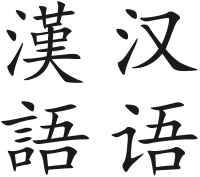Cheenese leid
| Cheenese | |
|---|---|
| 汉语/漢語 or 中文 Hànyǔ or Zhōngwén | |
 Hànyǔ (Cheenese) written in Hanzi | |
| Native tae | Fowkrepublic o Cheenae (PRC, commonly kent as Cheenae), Republic o Cheenae (ROC, commonly kent as Taiwan), Singapore, Hong Kong, Macau, Malaysie, Brunei, the Unitit States, Canadae, the Philippines, Australie, Thailand, Vietnam, Indonesie, Mauritius, Peru, an ither places wi Cheenese communities |
Native speakers | 1.2 billion (2004)[1] |
Sino-Tibetan
| |
Staundart forms | |
| Dialects |
|
| Cheenese characters, zhuyin fuhao, pinyin, Xiao'erjing | |
| Offeecial status | |
Offeecial leid in |
|
Recognised minority leid in | |
| Regulatit bi | In the PRC: Naitional Commission on Leid an Script Wirk[2] In the ROC: Naitional Leids Committee In Singapore: Promote Mandarin Cooncil /Speak Mandarin Campaign[3] |
| Leid codes | |
| ISO 639-1 | zh |
| ISO 639-2 | chi (B) zho (T) |
| ISO 639-3 | zho – inclusive codeIndividual codes: cdo – Min Dongcjy – Jinyucmn – Mandarincpx – Pu Xianczh – Huizhouczo – Min Zhonggan – Ganhak – Hakkahsn – Xiangmnp – Min Beinan – Min Nanwuu – Wuyue – Yueoch – Auld Cheeneseltc – Late Middle Cheeneselzh – Classical Cheenese |
| Linguasphere | 79-AAA |
 Cairt o the Sinophone warld.
Information: Kintras identified Cheenese as a primary, admeenistrative, or native leid
Kintras wi mair nor 5,000,000 Cheenese speakers
Kintras wi mair nor 1,000,000 Cheenese speakers
Kintras wi mair nor 500,000 Cheenese speakers
Kintras wi mair nor 100,000 Cheenese speakers
Major Cheenese speakin settlements | |
Chinese or the Sinitic leid(s) (汉语/漢語 Hànyǔ; 华语/華語 Huáyǔ; 中文 Zhōngwén) is a leid faimly consistin o leids that is maistly mutually unintelligible tae varyin degrees.[4] Oreeginally the indigenous leids spoken bi the Han Cheenese in Cheenae, it forms ane o the branches o Sino-Tibetan family o leids. Aboot ae-fift o the warld’s population, or ower ae billion fowk, speaks some variety o Cheenese as their native leid. Internal diveesions o Cheenese are uisually perceived bi their native speakers as dialects o a single Cheenese leid, raither than separate leids, although this identification is considered inappropriate bi some linguists an Sinologists.[5]
Spoken Cheenese is distinguisht bi its heich level o internal diversity, although aw spoken varieties o Cheenese are tonal an analytic. There atween seiven an thirteen main regional groups o Cheenese (dependin on classification scheme), o whilk the maist spoken, bi far, is Mandarin (aboot 850 million), follaed bi Wu (90 million), Cantonese (Yue) (70 million) an Min (50 million). Maist o thir groups is mutually unintelligible, although some, like Xiang an the Soothwest Mandarin dialects, mey share common terms an some degree o intelligibility.
Staundart Mandarin (Putonghua / Guoyu / Huayu) is a staundardised form o spoken Cheenese, based on the Beijing dialect, whilk is pairt o a lairger group o North-Eastren an Sooth-Wastren dialects, aften takken as a separate leid. The Mandarin Cheenese leid is referred tae as 官话/官話 Guānhuà or 北方话/北方話 Běifānghuà in Cheenese. Staundart Mandarin is the offeecial leid o the Fowkrepublic o Cheenae (PRC) an the Republic o Cheenae (ROC, an' a' kent as Taiwan), as weel as ane o fower offeecial leids o Singapore. Cheenese—de facto, Staundart Mandarin—is ane o the sax offeecial leids o the Unitit Naitions. O the ither varieties, Stanudart Cantonese is common an influential in Guangdong Province an Cantonese-speakin owerseas communities, an remains ane o the offeecial leids o Hong Kong (thegither wi Inglis) an o Macau (thegither wi Portuguese). Min Nan, pairt o the Min leid group, is widely spoken in soothren Fujian, in neighbourin Taiwan (whaur it is kent as Taiwanese or Hoklo) an in Sootheast Asie (kent as Hokkien in Singapore an Malaysie).
References
[eedit | eedit soorce]- ↑ Cheenese Academy o Social Sciences (2012), p. 3.
- ↑ china-language.gov.cn Archived 2015-12-18 at the Wayback Machine (in Cheenese)
- ↑ "Speak Mandarin Campaign". Retrieved 9 August 2011.
- ↑ * David Crystal, The Cambridge Encyclopedia of Language (Cambridge: Cambridge University Press, 1987) , p. 312. “The mutual unintelligibility of the varieties is the main ground for referring to them as separate languages.”
- Charles N. Li, Sandra A. Thompson. Mandarin Chinese: A Functional Reference Grammar (1989), p 2. “The Chinese language family is genetically classified as an independent branch of the Sino-Tibetan language family.”
- Jerry Norman. Chinese (1988), p.1. “The modern Chinese dialects are really more like a family of language.
- John DeFrancis. The Chinese Language: Fact and Fantasy (1984), p.56. "To call Chinese a single language composed of dialects with varying degrees of difference is to mislead by minimizing disparities that according to Chao are as great as those between English and Dutch. To call Chinese a family of languages is to suggest extralinguistic differences that in fact do not exist and to overlook the unique linguistic situation that exists in China."
- ↑ Mair, Victor H. (1991). "What Is a Chinese "Dialect/Topolect"? Reflections on Some Key Sino-English Linguistic Terms" (PDF). Sino-Platonic Papers.
| Wikimedia Commons haes media relatit tae Chinese languages. |

